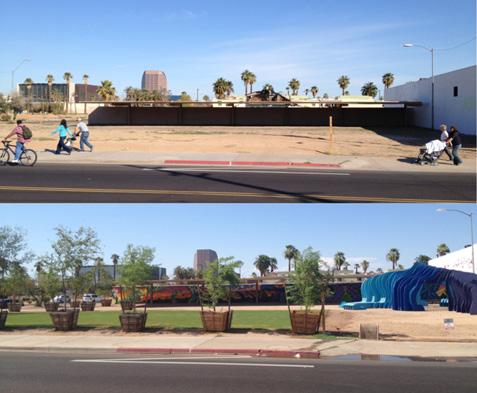
3 minute read
Tactical Urbanism
Vacant Land
There is no internationally accepted definition of what constitutes ‘vacant’ land (O’Callaghan, C. and Lawton, P., 2015). But the broad definition according to Nemeth (2013) is vacant land to include all land that is unused or abandoned for the longer term, including raw dirt, spontaneous vegetation and emergent ecologies, land with recently razed buildings, perimeter agricultural land fallen out of cultivation, brownfields and other contaminated sites, or land that supports long-term, abandoned derelict structures. When a structure sits on the property, some contend that a structure is abandoned, and its lot considered vacant, when it has been unoccupied for 60 days; others use 120 days or longer. Vacant land can be zoned residential, commercial, industrial or some combination thereof (Nemeth, 2013). Much of the increase in vacant land in recent decades occurred due to shifts from an industrial to service, economy and the expensive clean up and negative image of environmentally degraded land, suburban migration, the shift to a more mobile workplace, weak economic cycles and disinvestment in infill property (Nemeth, 2013). Also, political and economic in nature. Vacant land is the result of spatial fluctuations in urban development, which are intensified in the global reorganisation of output (Madanipour, May 2017). Individual decisions, market operations or public policies generate patterns of investment and disinvestment within and across localities (Garvin, June 2013).
Advertisement
2.1 EFFECT OF THE VACANT LAND
The vacant land causes suburbanisation, whereby houses, shops and offices migrate to car-dependant, larger spaces in the suburbs, hollowing out city centres in much of the world. Additionally they involve the consequences of planned improvements, creating a waiting game, a planning blight, whereby the possibility of change prevents new investment in an area, losing economic value and operation. Emptiness follows the loss or realignment of functions, on small or large scales. (Madanipour, May 2017). Vacant lots can create significant problems for surrounding neighbourhoods, including reduced property values and increased crime, as they attracted illegal activity because decaying structures and overgrown lots provided cover for people engaging in illicit behaviours (Garvin, June 2013). From the negative externalities may in fact serve to increase vacancy by pushing responsible homeowners to leave declining neighbourhoods (Megan Heckert & Jeremy Mennis, 2012).
2.2 BARRIERS TO DEVELOPING VACANT LAND
According to James, 2001 to have a permanent redevelopment for the vacant land, there are different obstacle opposing the development.
First, financial barrier, despite the low property values in many distressed urban neighbourhoods, the cost of these properties, which are sometimes small and oddly shaped, is often higher than the price of equivalently-sized properties outside the urban centre. In addition, virgin properties in fringe areas are free of many of the problems that plague even previously residential, empty urban properties: the presence of constructions that must be torn down before the land can be redeveloped; potential environmental contamination from asbestos or other toxic substances; encumbrances (property taxes, utility liens, mortgage liens, demolition liens, etc.).
Secondly, Regulatory and Institutional Barriers as zoning regulations can be a significant barrier to redevelopment and Systems, rules, and procedures established as part of government bureaucracy.
Thirdly, Physical Barriers as environmental constraints, small size, sometimes awkward shape of urban parcels and individual barriers as people’s perception about a neighbourhood, or property owners may create obstacles by an unwillingness or an inability to allow redevelopment or neighbourhood opposition to specific redevelopment projects can lead to their ultimate demise (James Goldstein, 2001).
Thus, these vacant lands, it seems an opportunity for the urban planners and tactical urbanism experts to develop and implement temporary interventions. On one hand, these temporary uses can be seen as tools of urban planning and management, and on the other hand as intrinsically valuable spaces and processes.




